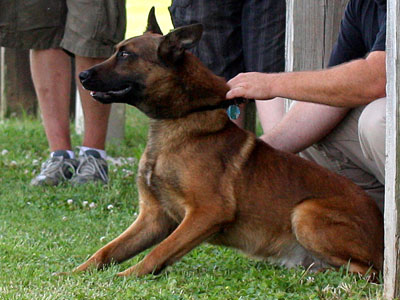
Because of the increasing dog population and lack of good qualified trainers, K9 Solutions Center offers a professional dog Trainer/Instructor course. As a Student Trainer/Instructor, you will not only learn how to train all types of dogs, but will also be able to instruct other people how to train their dogs. Our teaching theory is for us to, "Train you to train your dog". As a professional trainer, you will be able to pass this theory on, and build a strong training structure. A career in dog training can be satisfying and rewarding.
REAL-WORLD, HANDS-ON
Introduction and Orientation/Familiarization
Unit Description: This unit of instruction will provide the students with the general background required to
be a successful canine handler. The students will be introduced to the canine facility. Safe and proper
handling of the canine and the handler's responsibilities will be emphasized. The various types of canine
training equipment utilized and its proper care will be demonstrated. General canine care and grooming
will be discussed.
Student Performance Objectives: Upon completion of this unit of instruction, the student will be able to:
1. Explain the importance of reward, praise, patience, consistency and timing in the training of a canine.
2. Identify all safety aspects to be followed during handler safety.
3. Demonstrate the proper use of all equipment to be utilized.
4. Explain the necessary maintenance of the canine and kennel.
Written Proficiency:
1. Explain the importance of reward, praise, patience, consistency and timing in the training of a canine.
2. Identify all safety aspects to be followed during handler safety.
3. Explain the necessary maintenance of the canine and kennel.
Practical Proficiency:
1. Demonstrate the proper use of equipment to be utilized.
Psychology of Canine Training
Unit Description: This unit of instruction will inform the students on how canine psychology directly relates
to training procedures by observing the canine attitude, reaction and behavior. Conclusions from these
observations will be discussed.
Command Delivery
Obedience
Obstacle/Ability/Agility
Unit Description:
Command Delivery
This unit of instruction will provide the students with an introduction to the basic obedience commands. The
importance of the proper tone, volume and voice inflection and the necessary difference between a
command, praise and reprimand delivery will be emphasized.
Obedience
This unit of instruction will provide the students with those commands required for obedience and work
skills utilizing the "heel, no, sit, stay, come, and down" commands, both on and off lead.
Obstacle/Ability/Agility
This unit of instruction will build self-confidence in the canine, build the physical condition of the canine,
and introduce the variety of obstacles to which the canine and handler are exposed.
Student Performance Objectives: Upon completion of this unit of instruction, the student will be able to:
1. List the obedience commands to be taught to the canine both on and off the lead.
2. Explain the rationale for teaching all canine and handlers uniform commands.
3. Demonstrate the ability to verbally and manually execute all commands with the canine on the lead
and at various distances from the canine while on lead.
4. Demonstrate the ability to verbally and manually execute all commands with the canine off the lead
and at various distances from the canine while off lead.
5. Demonstrate the proper techniques to correct the canine when commands are not obeyed, explaining
the rationale for not threatening verbally or demonstrating gestures of threat to the canine when failing
to execute a command.
6. Demonstrate hand signals and explain the use of different voice tones when giving commands.
7. Assist the canine to safely negotiate all obstacles and under varying footing conditions.
8. Demonstrate tolerance to other canines throughout obedience lessons.
9. Demonstrate ability to perform drill formations.
10. Demonstrate a familiarization of gunfire reaction exposure.
Written Proficiency:
1. List the obedience commands to be taught to the canine both on and off the lead.
2. Explain the rationale for teaching all canine and handlers uniform commands.
3. Explain the ability to verbally and manually execute all commands with the canine on the lead and at
various distances from the canine while on lead.
4. Explain the ability to verbally and manually execute all commands with the canine off the lead and at
various distances from the canine while off lead.
5. Explain the proper techniques to correct the canine when commands are not obeyed, explaining the
rationale for not threatening verbally or demonstrating gestures of threat to the canine when failing to
execute a command.
6. Explain hand signals and explain the use of different voice tones when giving commands.
Practical Proficiency:
1. List the obedience commands to be taught to the canine both on and off the lead.
2. Demonstrate the ability to verbally and manually execute all commands with the canine on the lead
and at various distances from the canine while on lead.
3. Demonstrate the ability to verbally and manually execute all commands with the canine off the lead
and at various distances from the canine while off lead.
4. Demonstrate the proper techniques to correct the canine when commands are not obeyed, explaining
the rationale for not threatening verbally or demonstrating gestures of threat to the canine when failing
to execute a command.
5. Demonstrate hand signals and explain the use of different voice tones when giving commands.
6. Assist the canine to safely negotiate all obstacles and under varying footing conditions.
7. Demonstrate tolerance to other canines throughout obedience lessons.
8. Demonstrate ability to perform drill formations.
9. Demonstrate a familiarization of gunfire reaction exposure.
Proficiency Testing Standards:
The following exercises must be performed both on and off lead.
1. Heeling:
The canine walks next to the handler for two (2) right turns, two (2) left turns and two (2) about turns.
2. Walking:
In a walking motion, the handler must sit and down the canine and move at least seven (7) feet away
from the canine.
3. Distance:
The handler must sit dog and move at least ten (10) feet. Utilizing voice and/or hand commands, the
handler must down, sit and recall canine.
4. Agility:
The canine must perform three (3) hurdle jumps placed fifteen (15) feet apart with hurdle being no higher
than three (3) feet, utilizing one of the following: solid wall, chain link, picket fence, or window jump.
The canine must demonstrate a crawl under a fence, wall, or barricade with a ground to obstacle
clearance of sixteen (16) inches.
The canine must climb and descend a six (6) foot minimum staircase.
Theory of Scent
Unit Description: The principles of scent theory will be examined.
Student Performance Objectives: Upon completion of this unit of instruction, the student will be able to:
1. Understand and explain the theory of scent as it applies to narcotics detection, area searches, article
searches, tracking, trailing, and building searches.
2. Recognize and identify the canine's sight, sound and scent alerts.
3. Explain the checking of wind direction.
Written Proficiency:
1. Understand and explain the theory of scent as it applies to narcotics detection, area searches, article
searches, tracking, trailing, and building searches.
2. Recognize and identify the canine's sight, sound and scent alerts.
3. Explain the checking of wind direction.
Drug Detection
Unit Description: This unit of instruction will provide the students with the proper search procedure to seek
out and discover drugs. The students will become familiar with drug detection, the types of searches
conducted by a drug detection canine, and the team approach to canine drug detection.
Student Performance Objectives: Upon completion of this unit of instruction, the student will be able to:
1. Demonstrate the ability to organize and control a systematic and proper search effort.
2. Demonstrate the ability to combine control and decision making skills with that of the canine to
successfully discover drugs.
Upon completion of this unit of instruction, the canine will be able to:
1. Demonstrate a natural retrieve interest allowing for each motivation, good agility, confidence, and
people tolerance.
2. Demonstrate the ability to detect the scent of the following substances: cocaine, heroin,
methamphetamine, cannabis or any derivative thereof.
3. Demonstrate the "alert" activities when drugs have been discovered.
Proficiency Testing Standard
Outdoor Search:
1. Five (5) vehicles shall be used. The vehicles may be of any type or model and may include
automobiles, trucks, buses, airplanes, boats, etc.
2. The vehicles may be placed in any order or position as long as the teams have access to them.
3. The narcotics will be placed so as not to be retrieved by the dog.
4. The narcotics will be placed either on the outside or inside the vehicle.
5. No two hides will be placed on the same vehicle.
6. There will be a ten (10) minute time limit with a two (2) minute warning on the vehicle search.
Indoor Search:
1. The indoor search will consist of three (3) rooms. Each room will be a minimum of 400 square feet.
There will be a time limit of one and one half minutes (1.5) per 100 square feet.
2. The rooms must be furnished.
3. There will be two (2) hides contained within the three rooms, with no more than one (1) find in each
room.
4. The narcotics will be placed so as not to be retrieved by the dogs.
5. The narcotics will be placed at any height below the standard eight (8) foot ceiling.
6. There will be a two (2) minute warning before time expiring for the exercise. At the expiration of time,
the handler must call his finds.
7. The handler can use their allotted time to search any of the rooms, at their discretion. The individual
keeping time will stop time allowing the judges and handler to move from one room to the next. Time will
start when the team resumes the search.
Medical and First Aid/Care and Feeding
Unit Description: This unit of instruction will familiarize the students with basic first aid, hygiene and
nutrition and the proper methods and techniques used to maintain and care for a canine.
Student Performance Objectives: Upon completion of this unit of instruction, the student will be able to:
1. Demonstrate the proper method of daily health care, muzzling and transport of the canine.
2. Identify basic health hazards to the canine.
3. Explain and demonstrate basic first aid and basic grooming needs of the canine.
4. Explain the proper maintenance and sanitation of the kennel facility.
Written Proficiency:
1. Explain the proper method of daily health care, muzzling and transport of the canine.
2. Identify basic health hazards to the canine.
3. Explain and demonstrate basic first aid and basic grooming needs of the canine.
4. Explain the proper maintenance and sanitation of the kennel facility.
Practical Proficiency:
1. Demonstrate the proper method of daily health care, muzzling and transport of the canine.
2. Explain and demonstrate basic first aid and basic grooming needs of the canine.
Legal Aspects and Case Reporting of Drug Detector Canines
Unit Description: This unit of instruction will familiarize the students with the drug detector canine, the
Fourth Amendment, search and seizure, search warrants, and asset forfeitures. This unit of instruction will
also explain the importance of properly completed case reports.
